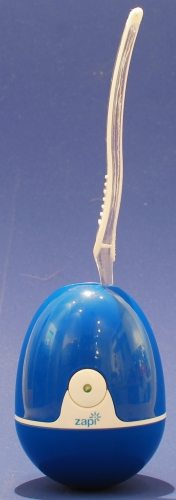 Since I first heard about how germs spray all around your bathroom when you flush, I’ve been a little icked out by the thought that my toothbrush is stored in there. A couple of years ago, I got a countertop UV sanitizer that stores and sanitizes my family’s toothbrushes. When Julie offered the Zapi UV toothbrush sanitizer from Violight for review, I asked if I could try it. I thought it would make a great little unit for traveling. (I really don’t like leaving my toothbrush in a hotel bathroom.)
Since I first heard about how germs spray all around your bathroom when you flush, I’ve been a little icked out by the thought that my toothbrush is stored in there. A couple of years ago, I got a countertop UV sanitizer that stores and sanitizes my family’s toothbrushes. When Julie offered the Zapi UV toothbrush sanitizer from Violight for review, I asked if I could try it. I thought it would make a great little unit for traveling. (I really don’t like leaving my toothbrush in a hotel bathroom.)
The Zapi sanitizers are little egg-shaped units that hold one toothbrush. They are available in a variety of colors, and some are even decorated to look like little ninjas, cats, and pirates. I was sent the blue one. The Zapi uses “germicidal ultraviolet light to kill 99.9% of germs on your toothbrush in just minutes.” The UV bulb in the unit does not seem to be replaceable. The bottom is weighted to keep the Zapi upright when the toothbrush is in. They require three AAA batteries, not included. Uncover the battery compartment by unscrewing the weighted bottom piece. You can pop off the top cover and remove the drip tray for easy cleaning. The Zapi even includes a toothbrush; it’s the clear/white toothbrush in the top picture.

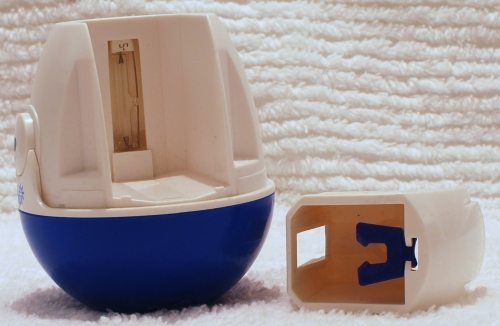
You just push your toothbrush into the hole in the top of the Zapi, snap the toothbrush into the rubbery plastic holder, and press the button on the front of the unit. The UV light inside the Zapi shines on the toothbrush bristles for six minutes, and voila!, your toothbrush is sanitized.
I tried the Zapi, and it worked just as I described. There is a blue LED in the middle of the power button that shines during the sanitizing process to warn you that the UV light is on. Violight cautions that you shouldn’t look directly at the UV light while it is on. They should also warn you not to look at the blue LED – that thing is blinding!
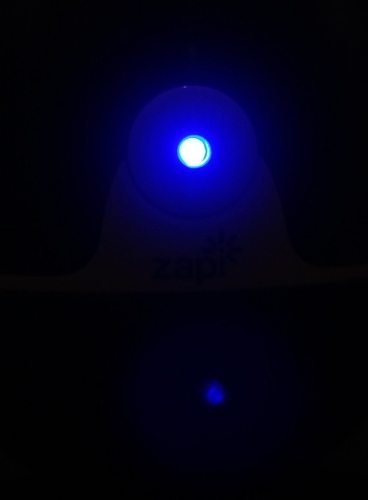
I was talking to Julie about the Zapi and I said I wondered if the UV lights actually did anything other than shine a pretty blue light on the toothbrushes. I decided I’d see if I could try to grow some bacterial cultures. Theoretically, there should be germs on a toothbrush that just sits out in the bathroom and on one just after brushing your teeth, and there should be virtually none on the sanitized toothbrush. If I could find some way to grow a culture, I should be able to prove just this very thing. Or perhaps I’ve just taken too many science classes in my life or just watched too much CSI…
To prepare for this test, I needed a used toothbrush. I decided I did NOT want to know what I could culture from my mouth or even from my sanitized toothbrush, so I decided I’d prepare a specimen another way. I wet the freebie toothbrush and hung it in the ceramic toothbrush holder built in to the tile on the bathroom wall. I’d wet this toothbrush two or three times a day – just like a tooth brushing schedule. Just to be sure, I once or twice gave the bathroom sink a quick wipe with the bristles. Reports always say the kitchen sink is dirtier than the toilet seat, so the bathroom sink should be germy, too. I kept doing this for a week to see what would collect on the brush. Now to perform the test.
Anyway, I’m long out of college and I have no access to proper biology lab equipment to grow these cultures. I can’t get any Petri dishes and agar-agar, but I’m resourceful. I cut down some plastic cups and sterilized them with alcohol. I decided I’d try lemon Jell-O as my culture medium. I mixed up the Jell-O and poured about a half-cup into each of my three specimen cups. I closed them up in Ziploc bags, and then put them in the fridge to cool and solidify. After they were jelled, I took them out of the fridge. I labeled one “control”, and I left it closed up tight. The second was labeled “before”, and I took the test toothbrush, and tapped the bristles in several places over the surface of the Jell-O. I could tell I’d made good contact, because the bristles left little dimples on the surface. I closed this cup back into its Ziploc bag. I then put the test toothbrush into the Zapi and ran the six-minute long sanitizing cycle. After the Zapi turned off, I tapped the toothbrush bristles in several places on the surface of the last Jell-O cup. Bristle marks showed I’d made good contact, and I labeled this cup “after” and zipped it back up in its bag. I left all the specimen cups sitting at room temperature and waited to see what would grow.
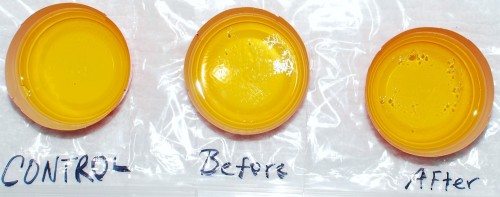
I checked my cultures every day for four days before giving up. Nothing grew on any of them. I guess that means my house is sterile, I did something wrong (likely), or Jell-O isn’t nutritious for microbes. Too bad – it seemed like such a good idea for some visual proof. As a note, in the picture it seems that the middle cup has a tree-like white growth in it. I was excited that I might have proof when I saw the picture, so I picked up the cup and really looked at it. Turns out there was nothing on the surface; it was just cracks or lines in the structure of the Jell-O under the surface. All three cups had those lines in them. It was just a coincidence that the “before” cup happened to catch the ceiling light just right to highlight the cracks. I was so disappointed!
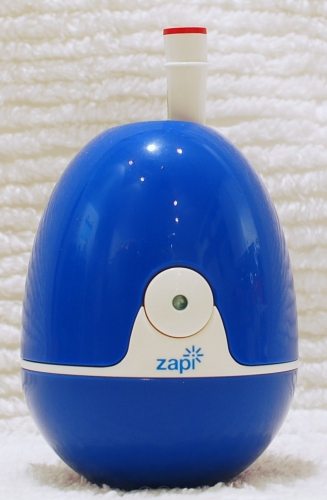
In any event, I’ve seen reports that show that UV light kills bacteria. So I’ll accept that as a given – the UV light in the Zapi kills bacteria. The Zapi works easily, and it holds regular toothbrushes and the head from a Braun electric toothbrush easily. It’s an easy and quick way to store and sanitize a toothbrush. I do wish the top opening was covered with a slotted rubbery gasket or something to prevent germ-y air from floating down on my sanitized toothbrush. The Zapi is a cute addition to a bathroom countertop, and it will be great to take when travelling to keep my toothbrush clean. The Zapi costs $29.95 directly from Violight.
INIU Mini Portable Charger, Small 45W PD Power Bank, 10000mAh USB C in&Out Fast Charging Pocket Size Battery Pack, Travel Essentials Powerbank for iPhone 17 16 15 14 Pro Air, Xiaomi, Samsung S24 etc
32% OffANDERY Car Phone Holder for Magsafe [78+LBS Strongest Suction & 2400gf Magnetic] 360° Adjustable Car Phone Mount, Phone Holders for Your Car for iPhone 17 Pro Max 16 15 14 13 12 Air Plus, Carbon Fiber
37% OffProduct Information
| Price: | $29.95 |
| Manufacturer: | Violight |
| Pros: |
|
| Cons: |
|



Gadgeteer Comment Policy - Please read before commenting
Is there some specific reason why the surfaces or the air in a bathroom is any different than that of any other room? I think not, unless one doesn’t keep the place clean.
How, exactly, do germs spray all around a room when one flushes? Do they magically jump up from the water? Do they rise and shine like scrubbing bubbles from some sanitizer?
Too much Mythbusters and not enough common sense will spread coliforms just about anywhere. It’s everywhere. Get used to it.
The goggle cabinets in my classroom/lab use UV lights to sterilize the goggles, so I think it’s the same principle for the toothbrushes…
Actually Twolane- Mythbusters busted the “toilet-aerosol-faecal matter” myth.
Anyway, for what it’s worth- I think an oversterilised environment is just as unhealthy as a filthy one.
Janet,
I appreciate you going out of your way to test the product and make your review more scientific.
I think we need to use jello in all our reviews from now on 🙂
@Hai Thank you. I was disappointed I couldn’t grow anything, though.
@Julie We could add the jello test to your creak test!
@Janet I think we should 😉
…and it 100% unneeded.
I disagree this review is scientific. I agree that science was attempted, which I really appreciate, but the result was clearly at best inconclusive, and at worst shows that the product does not work–yet the review itself then concludes that the product works!
If anybody wants to retry the experiment, agar is the usual growth media; you can find it in Asian grocery stores (the use of Jell-O was creative, but perhaps the flavorings or acid prevented good growth?). You can find some good bacteria experimentation instructions here: http://www.hometrainingtools.com/article.asp?ai=1245&bhcd2=1261436958
My own (unscientific) opinion is that such a product is totally unnecessary, and that germ exposure from toothbrushes is probably a negligible contributor to my health, either positive or negative.
Anyone that has ever had strep throat knows how bad the standard toothbrush cup can be…especially when there is more than one person’s toothbrush being placed in the cup.
A device that keeps people’s brushes separate and also helps in cleaning them is a good thing. It has also been a Woot a couple of times so the price isn’t bad either ($9.99).
I think that a blue light will not kill bacteria on the tooth brush.
@Stephanie The blue light you see in the photo is on the outside; it simply shows that the unit is on. The interior light emits ultraviolet radiation, which has been shown to kill microorganisms.
I have been using a counter top, battery operated violight for a year and I am about to throw it away. It may or may not keep bacteria off my toothbrush but it does NOT prevent black mold from forming on the brushes and in the bottom of the cups that hold the brushes. So I have my doubts about bacteria. I have to clean the unit out with bleach. I will take my chances with airborne bacteria.
I hear you Hariet. The two Violight Zapis that I got for my two kids also started to build up some kind of dark, moldy-looking substance in the drip cups. I admit that I have not been faithfully cleaning out the drip cups once a week (as the instructions indicated I should); I`m just not that organized/don`t always have time to deal with that. Perhaps against my better judgment, I just invested in two brand new Violights and tossed the old ones. I`ll try to be more consistent with cleaning out the drip cups this time around. It seems that Violight only sells replacement drip cups for another one of their products and not for the Zapi, so if these drip cups become irreversibly nasty as their predecessors had become, I’m going to toss these Zapis, too, and like you I will just `take my chances with airborne bacteria`, which I presume can`t be any worse than whatever microbes are lurking in that black moldy slime!